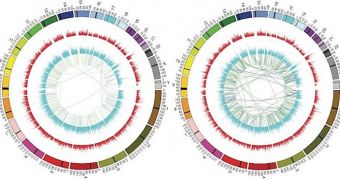The results of a new study on the genetic makeup of humans appear to indicate that subtle, little-studied differences between the fundamental architecture of individual genomes may be responsible for the genetic variation of our species.
Thus far, researchers believed that point-by-point mutations called single nucleotide polymorphisms (SNP) were the cause of these differences, but the new work indicates that this is not the case.
SNP have been studied extensively over the past few years, as they constitute the first place geneticists look when they are trying to detect the root cause of diseases. Numerous treatment targets have already been identified through these studies.
While the scientific community has been focusing on these mutations, the large-scale structural variations that the human genome display were largely left unstudied. These differences manifest themselves through a variety of ways.
These include additions or omissions of long DNA sequences, duplications and reversals of said sequences, and other large-scale changes that affect the genome. The study indicates that these changes play a fundamental role in the genetic differences between individuals.
“Our observations suggest that structural variations are more specific to individuals than single nucleotide polymorphisms are,” a team of scientists at the Beijing Genomics Institute (BGI) writes.
The experts, led by researcher Jun Wang, published the results of their analysis in the July 24 issue of the top scientific journal Nature Biotechnology, Wired reports. The group explains that large-scale changes are more difficult to detect than SNP on account of the technologies we use for such studies.
Most DNA sequences methods rely on breaking long strands of DNA apart into smaller pieces, and then trying to piece them back together. This is far cheaper and faster to do, and this is why observing large-scale variations is nearly impossible using existing apptoaches.
“One reason you’ve heard more about single nucleotide polymorphisms, that they’ve come to the fore even though they’re a more minor form of variation than these structural variants, is that they were easier to see,” Yale University bioinformaticist Mark Gerstein comments.
“Structural variations are a very hot topic. They’re probably the major form of variation in humans,” adds the expert, who was not a part of the current investigation.
In the new study, Wang and his team compared structural variations in the genomes of 106 people that were selected from the 1000 Genomes Project. Previously, the team used a proprietary technique of analyzing genome architecture in panda bears.
“Defining structural variations will be of considerable importance for future analyses of personal genomes,” the team concludes.

 14 DAY TRIAL //
14 DAY TRIAL //